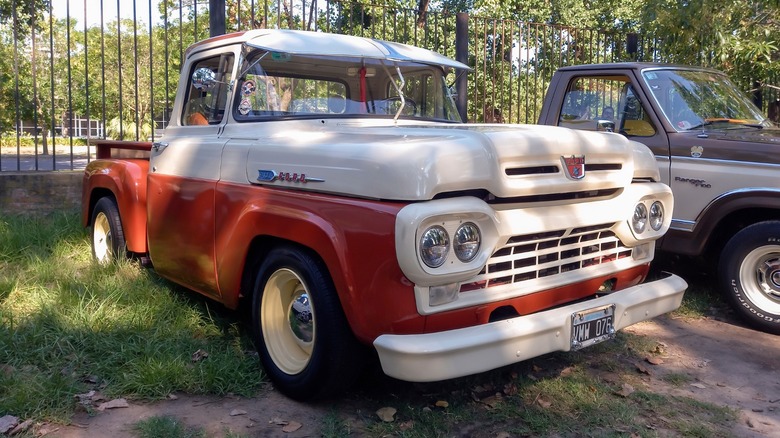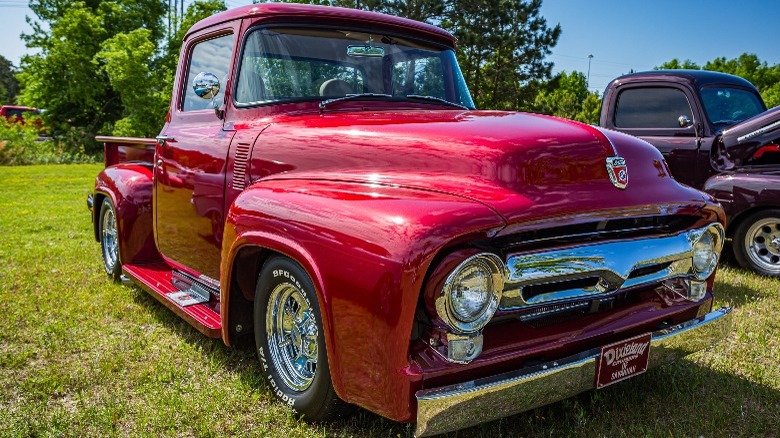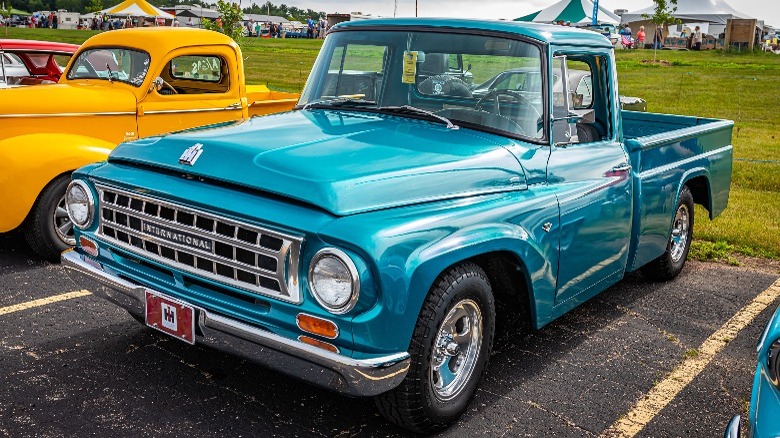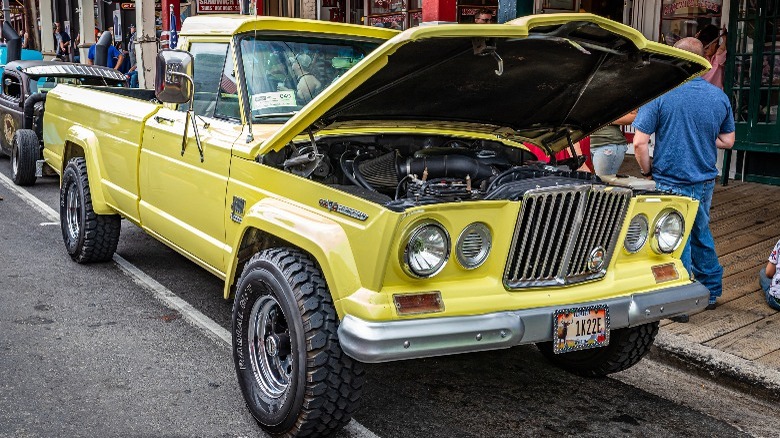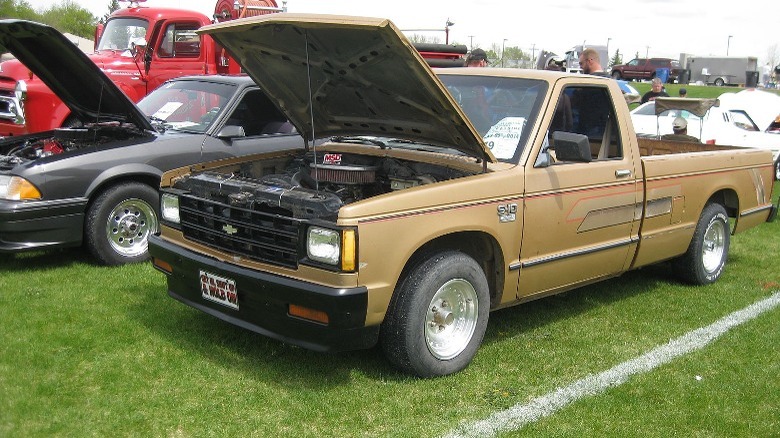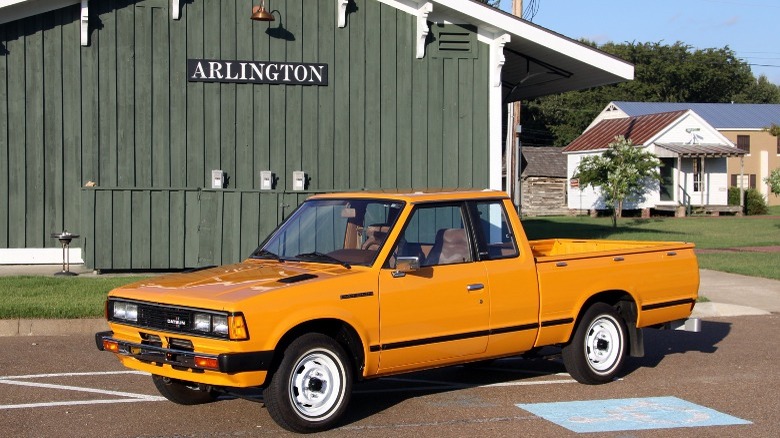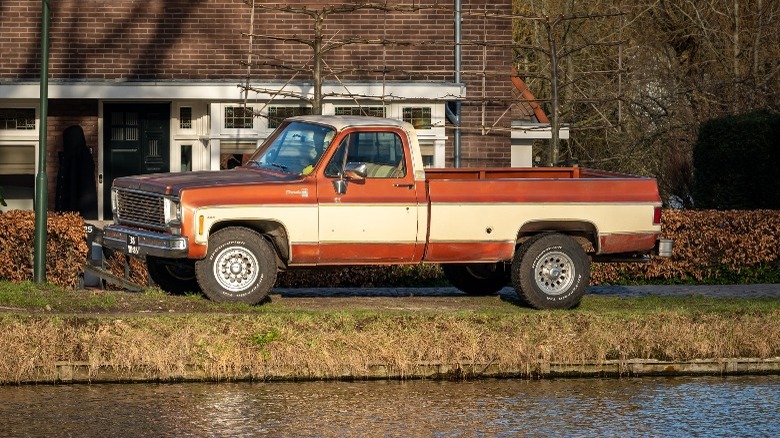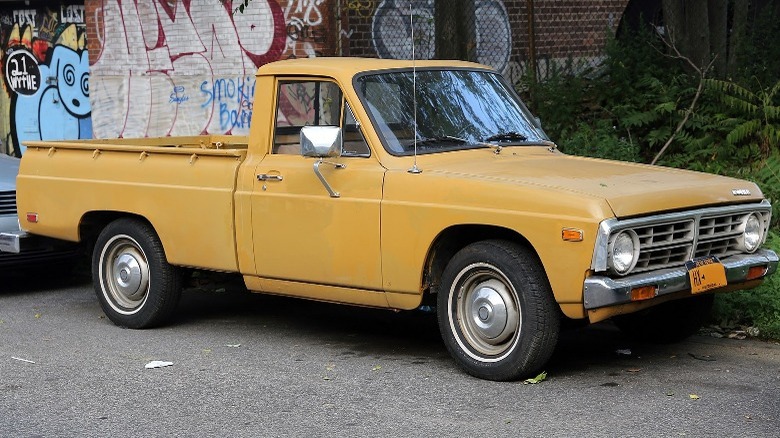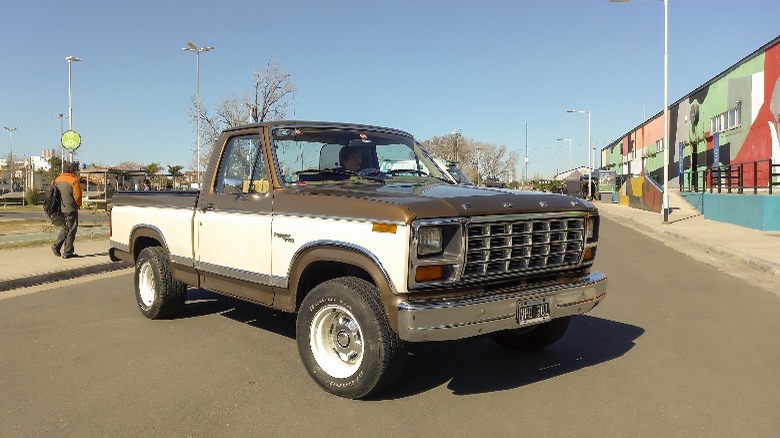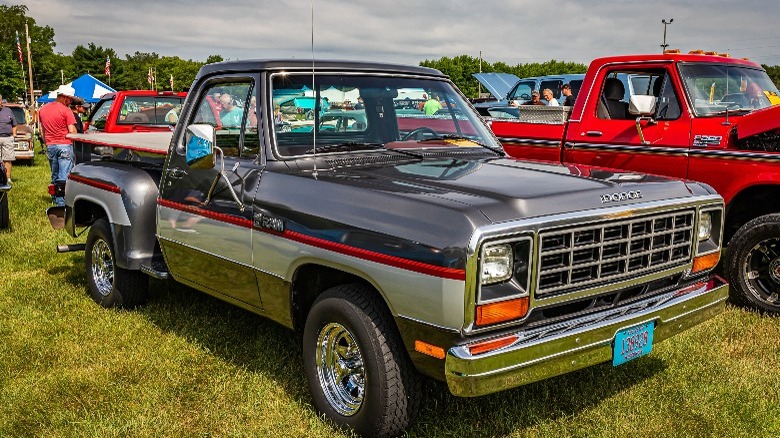9 Classic Pickup Trucks That Are Still Affordable (For Now)
The first pickup trucks created were more practical than aesthetic. For instance, Henry Ford's 1925 Model T Roadster was created to serve farmers who needed the cargo space of a truck bed to haul equipment and produce. Since then, the pickup has only continued to be in high demand, and countless models have been manufactured by almost every player in the automobile industry.
Over the years, the pickup evolved past its reputation as a utilitarian companion for blue-collar workers all around the U.S. and became a mix of not only practicality but aesthetics. It's safe to say that the pickup has cemented itself as an iconic vehicle form factor. With its historical significance and ever-growing popularity, it's no surprise that they have become collector's items.
With all of this, it's easy to feel like finding a great-looking and reliable pickup that's also affordable is virtually impossible. But that's really not the case. A couple of hidden gems still make great collector's items and serve as practical and reliable daily drivers. With that said, here are some affordable classic pickup trucks you can still buy before their prices go up.
Ford F-100 (1953-1956)
Ford made owning a car a real possibility for many in the United States, especially back in the '50s. Among its offerings was the second generation of the iconic Ford F-100. Launched in 1952 for the '53 model year, this car was a successor to the F-1 series. But with a new name and beautiful redesign, the F-100 really stole the show. Popularly called the 'Effie', it was marketed as the best vehicle for running around, perfect for getting the job done.
The F-100 came with the option of either an inline six-cylinder engine or a flathead V8 engine. In 1954, we saw the addition of a Y-Block V8 engine instead. Even though it was a workhorse, the F-100 did not skimp out on its looks. With its low suspension, chrome accents, and unique grille design, it was a great-looking car. And it was affordable too, even being one of the cheapest trucks from Ford Motors.
The Effie is one of the most iconic cars Ford has released, and it helped pave the way for the F-Series trucks we know today. The second-generation F-100's mid-century design is a timeless classic, though one of the pricier options on this list. If you're looking for a model with solid frames and a reliable Y-Block V8 engine, you can expect to pay between $10,000 to $20,000 depending on what condition it's in. This might be hard though, because this model was only in production for about four years, and the demand for it is getting higher by the day.
International Harvester C-Series (1961-1968)
The C-series replaced the B-series as the standard light to medium pickup truck in their line, but the wide range of truck capacities made it suitable for tasks that aren't typically light duty. In addition to the two-door, there was also a four-door, six-passenger option referred to as the 'Travelette,' which was a great choice for families.
The C-series was pretty much your average light-duty pickup. It wasn't fancy, in fact, there were barely any updates throughout its seven-year run. But it got the job done, with a simple interior and a powerful engine that could run all day without complaining. On the topic of its engine, The C-series came with various options, ranging from six to eight-cylinder engines, capable of handling a lot more than regular day-to-day tasks.
Although they're often overlooked, International C-series trucks deliver no-nonsense utility. Yes, they're light-duty pickups, but their robust construction makes them not only great as-is but also restoration-friendly. You can find a decent project truck starting around $6,000, with nicer examples closer to $15,000.
Jeep Gladiator (1962-1971)
Jeep introduced the Gladiator in 1962 for the 1963 model year as a replacement for its predecessor, simply called the Jeep Pickup Truck as it had no name. The Gladiator wasn't nearly as unremarkable. In fact, it was a revolutionary model at the time and stood out from other pickups offered by competitors. The Gladiator debuted with a six-cylinder engine known as the 'Tornado' which was one of the first overhead cam engines to be mass-produced in America. It also had the option of four-wheel drive independent front suspension, which was not very common at the time, especially for an off-road vehicle.
Visually, the Gladiator borrows its frame design from the Wagoneer, giving it that recognizable Jeep look we're all familiar with, and blends this with the classic pickup truck bed practicality. If you're looking for reliability this is a great choice, as Jeep even describes it as being "virtually indestructible." For a light pickup, the Gladiator works great for towing and hauling but is also a really good and dependable everyday vehicle.
The price range for a Gladiator varies, as you can find some for as low as $5,500 but if you're looking for one in really good condition, you could be looking at starting prices of around $10,000 to $15,000.
Chevrolet S-10 (1982)
Before the S-10 was introduced, the first compact pickup available from Chevrolet was the Chevrolet LUV which was basically a rebranded version of the Japanese-manufactured Isuzu KB. The issue here was that the LUV was still an imported light truck meaning that there was a 25% tax on it, making it expensive for Chevrolet to import and supply. As a workaround, Chevrolet replaced the LUV with the S-10 in 1982, which was the first compact pickup to be manufactured domestically by any of the big-three car manufacturers at that time.
One thing that made the S-10 a top pick was the fact that it came in a lot of variants and customization options. The standard came with a 1.9-liter four-cylinder engine, with the option to upgrade to a bigger 2.8-liter V6 engine. In the next model year, the option of an extended cab was added.
The S-10 was loved by both enthusiasts and everyday drivers alike for how much value they got, even with the compact form factor. Another plus was how easy and affordable it was to maintain and repair. Even though it wasn't technically meant for heavy-duty use, the option of a V6 engine meant it could do a lot more than some other compact pickups. Honestly, this is one of the Chevy's we think should never have been discontinued. The S-10 is a go-to if you're looking for a daily driver with that classic truck appeal. Classic.com has the average for these listed at around $12,000 but with some digging, you'll be able to find one for even cheaper.
Datsun/Nissan 720 (1980-1986)
Nissan introduced the Datsun 720 in 1979 in Japan and then in the U.S. the following year, as a continuation of a successful line of pickups. Despite coming from a foreign manufacturer, the Datsun 720 was a popular choice for those looking for a pickup truck, plain and simple, with no frills. This was actually the last generation to carry the Datsun name, after which it was dropped on the later models to simply Nissan.
The 720 came with a 2.0-liter inline four-cylinder engine, with no option for a six-cylinder engine, meaning it wasn't meant to be a performance beast. But it was still capable enough to handle the needs of the everyday consumer. The 720 was highly configurable. It offered both two-wheel and four-wheel drive variants. There was also the option of both a regular cab size and a bigger version, which Nissan called the 'King cab' for people who wanted a roomier cab even with a smaller truck size. In addition, buyers could also choose between a regular and a long bed.
An early entry into the compact truck market, early Datsuns offer fuel efficiency, no-nonsense utility, and that vintage quirkiness. Because Datsuns are made by a Japanese manufacturer, they tend to fly under the radar when most people are in search of a classic pickup. This means that it might be easy to find a solid model at a great price. Classic.com says the average cost is just under $10,000 but Datsun 720s have sold as low as $3,200.
[Featured image by Lee Mills via Wikimedia Commons | Cropped and scaled | CC BY-SA 3.0]
Chevrolet C/K Series (1973-1987)
Debuting in the 1987 model year, the third generation of the C/K marked a move by General Motors to blend comfort with the dependability of a classic pickup. Ironically, even though it was referred to as the 'Rounded line' by GM, the third-gen C/K was notable for its iconic 'square body' design. This was quite different at the time, especially for a Chevy, but it offered endless potential for customization.
GM intended for this model to be revolutionary in both form and function. Its boxy, utilitarian style build caught the eye of a lot of buyers because it was a fresh take on the pickup, a departure from the more traditional design we were used to. Interestingly, this generation of the C/K even underwent aerodynamic testing. It was important to GMC to develop a full-sized truck that was still fuel efficient. The C/K was available in both two-door and four-door configurations. Internally, it came with an inline six-cylinder engine but had several V8 options.
It was in production for 18 years, one of the longest-produced pickup trucks ever. Because of this, these pickups are relatively plentiful making them more affordable than a lot of other classic pickups. You can find many project trucks starting under $5,000, with good-condition drivers in the $15,000 range.
Ford Courier (1972-1982)
If you're looking for a compact truck like the Datsun but would rather go with an option from one of the big three, the Ford Courier is a compact and fuel-efficient alternative to larger pickups. The revival of the Courier, which launched in 1971 for the 1972 model year, was a deviation from its initial sedan delivery build style.
It was originally produced in collaboration with Mazda and shares its platform with the Mazda B-Series truck. The Courier was still produced in Japan and imported into the U.S. So, like the Chevrolet LUV, it was subject to the so-called chicken tax. Ford's solution was different from General Motors' though. They opted to import the Courier in a cab and chassis variant which meant that the tariff to be paid was drastically lower. The bed was then attached after it had been imported.
There wasn't much to the Courier. With limited base model options of 2.0-liter or less four-cylinder inline engines at launch and a simple classic design, there were no bells and whistles – just a plain old pickup truck. But this made it a no-brainer choice for daily driving or light-duty work. The average selling price for a 2nd Gen Courier is about $8,000 to $9,000, but there are some good project trucks that you can get for way less.
[Featured image by Mr. Choppers via Wikimedia Commons | Cropped and scaled | CC BY-SA 3.0]
Ford Ranger (1983-1992)
Another compact option on the list, the Ford Ranger is a favorite amongst collectors and enthusiasts. Bearing the codename 'Project Yuma' internally at Ford Motors, the Ranger emerged as a replacement for the Courier, which continued to be imported from Japan for the entirety of its run. Ford began the development of its first domestically manufactured compact pickup, prioritizing fuel efficiency and making a great quality vehicle.
At launch, the Ranger came in multiple engine variants, ranging from a 2.0 to a 2.9-liter, and were mostly inline four-cylinder engines with the exception of the 2.9-liter engine which came in a V6 configuration. This engine lineup was further expanded with later models. Like most pickups at the time, the Ranger came with rear-wheel drive but had the option of four-wheel drive. It offered two bed sizes initially and later introduced an extended cab option called the SuperCab in 1986.
The Ranger is only slightly bigger than the Courier, but it still has great towing and off-road driving capabilities, even with its light-duty, compact form factor. You can find one in good condition for less than $7,000.
Dodge Ram (1981-1993)
Last but not least is one of the biggest trucks on this list. As the name suggests, if you're looking for something beefier and rugged to tackle heavy-duty tasks, the Ram is a perfect choice. Introduced in October 1980, the Ram was a successor to Dodge's D-series pickups.
It came in different cab styles, from regular cabs to crew cabs, making it a versatile enough truck to be suitable for both contractors and families. It also had both rear-wheel and four-wheel drive options marketed as the 'Ram' and 'Power Ram' respectively. If you take a glimpse under the hood, it's clear that these were meant to be powerhouses. The Ram had the option of either a 3.7-liter six-cylinder engine or a 5.2-liter V8 engine. In 1989, Dodge added the option of a Cummings 5.9-liter inline six-cylinder diesel engine.
The Ram was also pretty nice on the inside too. A full-size pickup meant a spacious cab with enough room to stretch out even when on long hauls. It also came with small creature comforts like air-conditioning, radio, and a decent sound system.
Over its 12 years, the Dodge Ram gained a reputation for being a tough and reliable companion that could take on anything you threw at it. These tend to get a little pricey, but classic.com shows a couple in decent condition for around $6,000 all the way up to $18,000.
